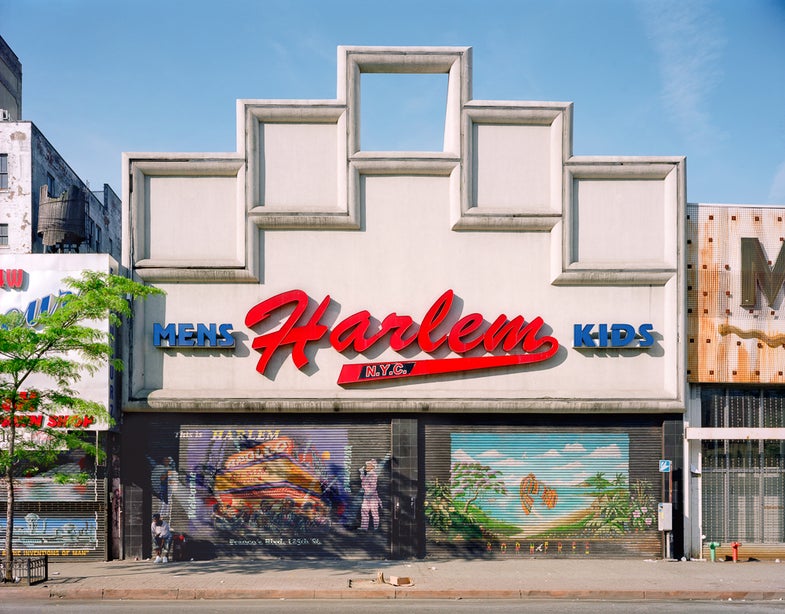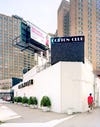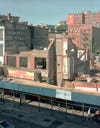Capturing Harlem’s Changing Face
Harlem, like many of New York’s neighborhoods, is in the midst of rapid flux. Rezoning, new construction projects and (of-course)...













Harlem, like many of New York’s neighborhoods, is in the midst of rapid flux. Rezoning, new construction projects and (of-course) gentrification are changing the face of this northern Manhattan neighborhood. This dense period of rapid transformation started nearly seven years ago, and as change started to come, two photographers teamed up to capture the altering identity of Harlem’s main thoroughfare, 125th Street. Working with a large format 4×5 camera, Edward Hillel and Isaac Diggs began walking the street from the Hudson to the Harlem River and making pictures. Now, they are gearing up to release a beautiful book of the work titled 125th: Time in Harlem.
Prior to the official release, Diggs and Hillel spoke to American Photo about the project.
How did the two of you begin working together on this project?
Isaac Diggs: We were introduced by a mutual friend who wanted us to photograph artist studios in Harlem together. Edward and I talked about that and it didn’t seem like an idea that we were particularly drawn to. We’d been working in Harlem as photographers individually before meeting. I had spent 10 or so years photographing in Harlem and Edward had been here years before making a documentary.
We were both at a point where we wanted to photograph Harlem, but in a way that was new for both of us. I had just purchased a 4×5 camera and was getting into that and we decided to just go out together and start exploring that equipment, but also this urban landscape that we were both very fond of and wanted to reinvestigate.
You started photographing for this project shortly after a zoning change took place in Harlem, what exactly had happened? Did that motivate you in any way?
Edward Hillel: The [Bloomberg] zoning plan would change the face of 125th Street—Harlem’s main street. We sensed, with other people in the community, that this was going to bring about big changes. I think that was definitely a driver for us to work on this particular project together.
Diggs: There was also the Columbia development taking place, not only the Bloomberg zoning, but the redevelopment that was going to happen from 125th almost up to 140th on the far west side—that area was going to change drastically too. The project certainly wasn’t about documenting that change. But we knew this was a pivotal time in Harlem’s history.
Hillel: Those two projects, which both kicked off as we started photographing, and would have been built much quicker, except there was this recession. That economic recession in 2008 basically slowed everything down, and in retrospect, gave us the time to make these pictures. The way we were working we couldn’t go out and shoot these in a week or a month.

How has the street changed since you started shooting in 2007?
Diggs: One of the amazing things for me about doing this is you would see the landscape change over the course of us working. The far west side for instance, one of the first pictures we made was from the elevated west side train line looking across 12th Avenue to the Hudson River to Jersey. That entire area has now been razed and rebuilt with the beginning of a Columbia building. It’s really dramatic the transformations, and very quick.
When we tell people were photographing for basically about four years, that doesn’t sound like a lot of time, until you consider what a condensed period that was. You had the real-estate boom in 2004, ’05, ’06—where people were moving to Harlem, housing prices for Brownstones were skyrocketing. There was this wave. We made our first pictures in 2007/2008 and then in late 2008, with the crash, suddenly this optimism burst like a balloon. You literally had holes in the ground because people had not only warehoused buildings, but they had also torn them down in anticipation of this development that was on the board and then just stopped. It was like a mouth that was missing teeth. You just had these blocks with buildings gone, businesses gone, that had been there for 20 to 30 years, a lot happened in that period. Toward the end of the project we started to get a sense, okay now these things, these projects, are back online. It was a very dense period of rapid transformation.
You were shooting these with a 4×5, how did the gear affect the story?
Diggs: Ground glass viewing allowed for Edward and I to look at the image, assess it, make suggestions, to see it clearly, which became so important working collaboratively. Just having that ground glass, where really we could both stand behind it and talk about what we were seeing together, instead of having to peer through a viewfinder. It was also a conversation starter, I think for people watching us work, there was a level of curiosity that would often compel them to come and see what we were doing. Later in the project we began to use that to our advantage.
Hillel: Someone would come up to us and start talking about the camera, say “oh my uncle had a camera like that,” and ask, “oh what are you guys doing?” We would explain to them what we were doing and they would tell us their opinions about the street, tell us what was there first and sometimes that would influence the way we would frame. But also we learned that it is not a black and white issue, literally and metaphorically. You’d have a homeless guy, right, who you would think would be totally petrified that this whole street is going to be ripped down and rebuilt and he would tell you “ah this is good. This is junk. There is no where to sleep. The sidewalks stink.”
Once you use a 4×5, it dictates how you work in so many ways. Some things you can quantify, but others just change how you as a photographer, emotionally decide how you’re going to look at a picture and think about it. Photographing this with a 4×5, I sort of know that I have all of these layers of spaces. In retrospect, I think it influenced this project a lot.
Diggs: It’s the kind of camera you can work with or against. I think we explored both possibilities. There were times when we consciously tried to use the 4×5 like a 35 mm. Then there were other times where we really appreciated and took advantage of the slow, methodical, process that that camera encourages to make pictures. Using that tool was interesting. It makes you conscious of the decisions that you are making. Beyond working collaboratively it was probably one of the three most important decisions that we made. I think working with the 4×5, working together and then choosing to just focus on 125th Street.

What were your guidelines for shooting, were there any important rules to maintain other than shooting on 125th Street?
Hillel: We didn’t say—we’ve got to cover every corner, we were interested in making strong pictures. We were really just interested in using 125th as a stage to tell what we felt was this important story: city changing, contested landscape, zoning, what different communities think and how the street was having that conversation with us. We weren’t looking at every street corner, but we were very conscious of the fact that 125th Street went from the Hudson to the Harlem River. We did walk it several times, but there were just spots where we didn’t feel a picture. This is as much a mental and emotional landscape as it is a geography.
How long were the shoots—how many locations would you visit per day?
Diggs: By this time I had moved out of the city. I used to live around the corner, but I moved to Newburgh, New York so we would get together about once a week, sometimes twice a week. Sometimes it was for a couple of hours and sometimes it was an all day affair. Usually over the summer, or before it got too cold.
Hillel: We wanted light, natural light. We would go out sometimes and the light was good. If it got to cloudy we would go, “well you know, we just lost our inspiration.”
I imagine the weather really dictates what kind of day you are going to have?
Diggs: It did. Once we became more aware of what we were doing, there were certain lighting conditions we were looking for, generally your normal blue sky and sunlight.
Hillel: But certainly not very strong shadows. The problem with shooting that street we found is that one side was always in the sun and the other side, unless you were there between 6:30-8 a.m., was always in shadow. It was okay if you had an overcast day but still had some feeling of light—we could think about the sidewalks bouncing light back up and into the buildings. We had to think about those kinds of strategies.
This project was inspired by these two major development plans, were you trying to make a statement with 125th Time in Harlem
Hillel: Harlem certainly needs a influx of cash and possibilities. How is it managed and how does it flow into the community, rather than erase the community, are the issues. That is the conversation.
Diggs: And we don’t have the answers to those questions obviously, but it was kind of like, how do you pose the question and how do you hopefully contribute to that dialogue. That was one of the major goals. We each have our opinion about the nature of the development. But we were very aware of making a work that wasn’t didactic or one sided—this is right, this is wrong—because it is more complicated than that, obviously.

What do you like the most about photographing Harlem? What draws you to this neighborhood?
Hillel: For me, it’s this idea of possibility that a picture can appear, in the most unexpected way or unconventional ways. I think what happens here is people wear their feelings and their emotions, and I’m talking about the buildings as much as I’m talking about the people—out there. I think that is a beautiful thing that Harlem has to offer.
Diggs: Harlem is one of those few spaces left in Manhattan, where a neighborhood is like writ large. You feel that in the lowness of the buildings. Very few buildings in Harlem are above two or three stories, so the sense of space and light and sky is very different. The wideness of the boulevards, public space and sidewalks, that is where culture plays itself out up here. Also the juxtapositions you see. Up until recently, there weren’t many corporate big box buildings in Harlem, 125th, they weren’t present, it was mom and pop. So it really had that flavor of neighborhood before that infusion of spaces that are common to the rest of the city.
Hillel: It had crafted its own identity. It didn’t look elsewhere. It kind of patched it together. Poverty could be a reason for that. Neglect is a reason for that. These are kind of negative things, but at the same time in terms of creating community, they create a situation where neighbors look out for each other and there are these ma and pa shops that are trying to keep going. That is a beautiful thing and it is beautiful to be inside it. It is also complicated to figure out what story to tell and how to tell that story.
Why was it important for the two of you to capture this moment in Harlem’s history?
Hillel: We felt it was an in-between moment for Harlem and though 125th Street had developed that identity, its own definition of who this is and what this community is about, that was going to change because of much larger forces, monetary and political forces. The decision had been made elsewhere for this community. We felt that we had this time to do it. I think that was the biggest reason.
Diggs: When you think of Harlem you think of the Harlem Renaissance, maybe you think of the riots that followed the Civil Rights movement. This moment is another one of those moments. I think when another history of Harlem is written they will talk about this time as being as pivotal a time as that post Civil Right period, or the Harlem Renaissance, as far as the face of Harlem changing. A new period in Harlem’s history is beginning.
An official book launch for 125th: Time in Harlem will be held Thursday, Oct. 23 at Aloft Hotel Harlem. On Monday, Oct. 27 Diggs and Hillel will join Vicki Goldberg for an Artist’s Conversation at SVA Theater. Work from the book will be on display at Claire Oliver Gallery starting Dec. 11, 2014.

